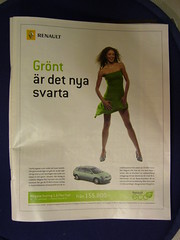Green is the new black is the new green?
August 21st, 2007I recently received a t-shirt from Greenvoice, courtesy of Andrew Nesbitt, as a thank you for testing out the site.

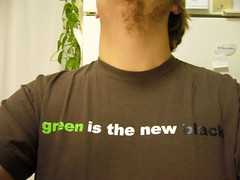
The left image is the back of the shirt, but I had to wear the shirt the wrong way around to be able to take the shot.
The T-shirt is pretty good looking, but a few points of criticism:
- They decided to put the brand on the back of the shirt. That’s a total nono from a marketing point of view! People pay more attention to the message on the front of a shirt, as that’s usually the side of a person you’re looking it when communicating with her. The back can also be covered with for example a jacket, or as in my case, a backpack. From the designer’s point of view I can understand the decision, kind of, but I still think it would’ve been a good idea to at least print the URL in the front.
- Black text on brown fabric! Of course the word black should be in black for best effect, but the color of the fabric should be adjusted accordingly.
- The punchline! As it seems, the slogan “Green is the new black” is far from unique. This is not a problem at all really, since the mesage fits the size, especially since it has the word green in the URL. The reason I’m mentioning is that I’ve seen (almost) the same punchline twice since I got the shirt. First Google asks Is green the ne black?, referring to the fact that you can save energy by turning your electronics off. Then I saw the original punchline in a Swedish magazine. (Displayed below)
I’ll continue by describing yesterday in photos:
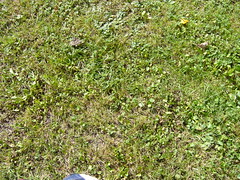

I was at my grandpa’s, picking apples. Here are two shots from when and sat down for some rest. One totally useless lawn shot, and on shot from above my head to see how wll I managed to cut my half hairstyle.
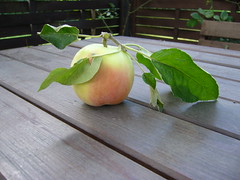
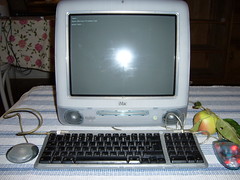
Here’s an apple I picked, and shot on the garden table. An ok shot, isn’t it? Then what I believe to be the same apple next to another Apple, an iMac that I found in the trash. The OS is Debian (Etch) if anyone wonders. And to the other question, no, it didn’t have Linux installed when I found it, but Mac OS 9. ![]()
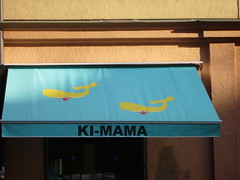
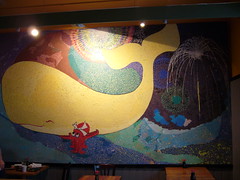
Next up I had some sushi at the sushi bar Ki-Mama. Any rumours you might have heard about it are totally true, this place in one of the best sushi bars in Stockholm. The only little complaint is that the rice could’ve been more sticky. I eat sushi with sticks, and the rice cushion fell apart for two of the pieces. (The alliteration sticky <-> sticks is unintentional) Unfortunately I didn’t remember I had my camera with me until I had finished my dish. :/
But what truly love about the place is the fantastic wall art! At first it might look like a painting, but in fact it consists of torn, round stickers and small pieces of papier marché. To me it seems to be made in a true Zen fashion. Every piece must be put in the exact right spot, and it must’ve taken a lot of perseverance to get them all in place. Likewise, the material is bound to age and degrade over time, also true to the Zen mentality.
Here are a couple of close-ups of the mosaic:
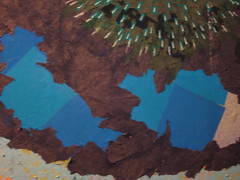
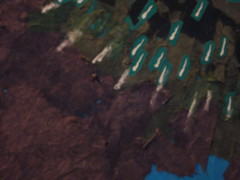
^^ Close-up of the hot springs
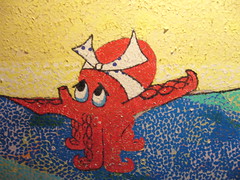
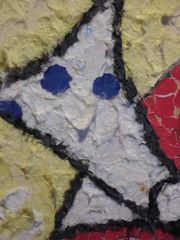
^^ Close-up of the octopus-sensei
So, a question to my readers. I want to know whether there is a symbolism in the theme? Does anyone know the artist who made the mosaic?
These are my theories: It’s clearly related to the sea. (What else to expect in a sushi bar?) The thing to the right is possibly a fireworks explosion, but probably a hot spring. I have a little theory that it could be a blow from the whale’s blowhole that has somehow been displaced.
The two main objects in the picture are the whale and the octopus. The octopus is carrying the whale, and as can be seen on the lower left close-up, he’s carrying the whale with one sucker on the viewer’s side of the whale.
According to my theory, the octopus is the hard working sushi chef, who without trouble can handle a fish as big as a whale. (I know that whales are mammals, but that sentence would have felt unnatural if I had used some other construction like “sea creature”. Besides, that sentence is not strictly saying that a whale is a fish, only comparing the size of fish vs a whale)
So does anyone know a deeper meaning, or can see any cultural Japanese references that I’m unaware of?
![You suck at protoshop. No, you [i]really[/i] oo.](http://blog.gg8.se/images/you-suck-at-photoshop-you-really-do-your-awful.png)



